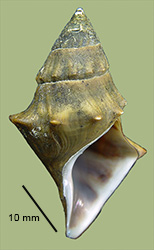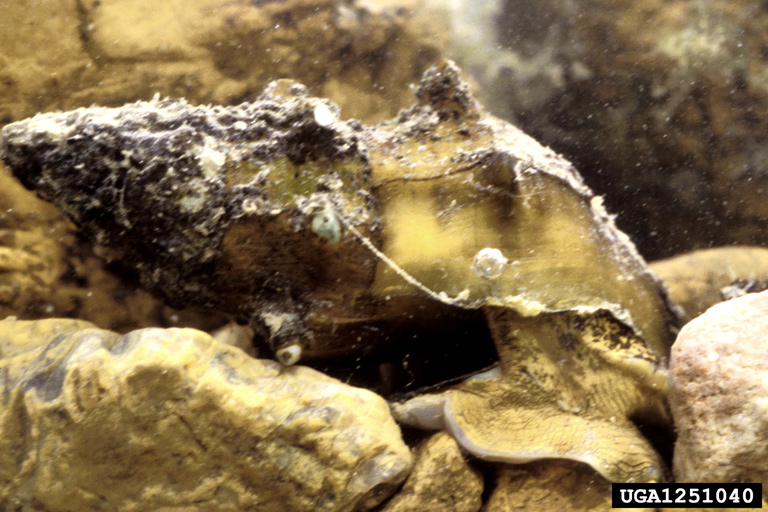> Habitat & Distribution
Historically Io fluvialis ranged throughout the large rivers of East Tennessee, as far west as Muscle Shoals (Lewis 1876, Adams 1915). But the impoundment of the Tennessee River and most of its major tributaries in the 20th century extirpated the species from all but the upper Powell River, the upper Clinch River, and a small region of the lower Nolichucky (Stansbery & Stein 1976, McLeod & Moore 1978). In the 1970s and 1980s the species was reintroduced to the North Fork Holston River in Virginia (Ahlstedt 1991). Within its rather restricted range, Io fluvialis inhabits rocky riffles with good flow. FWGNA incidence rank I-4.
> Ecology & Life History
Grazing by populations of pleurocerids can have a significant effect on energy flow in small streams (Dillon 2000: 86 - 91, see also Dillon & Davis 1991).
Like other pleurocerids, Io fluvialis is dioecious, eggs being deposited on hard substrates from spring to mid-summer. Although we are unaware of any study specifically directed toward the life history of I. fluvialis, it seems reasonable to expect that two years will be required for maturity, and that several years of iteroparous reproduction can be expected thereafter, as is the case for pleurocerids generally (Dazo 1965). This is life cycle Hi of Dillon (2000: 156 - 162).
> Taxonomy & Systematics
Variation in the spire height and spinosity of the shells born by Io fluvialis led earlier workers to author a large number of Latin nomena for the species, now long synonymized (Lutz & Weese 1951). The taxonomic status of fluvialis as the only species in the monotypic genus Io is now uncontroversial. An Io shell serves as the logo of the American Malacological Society.
Jenkinson (2025) reported a karyotype of 2N = 34.
> Maps and Supplementary Resources
> Essays
- Conservation-biased oversampling of Io fluvialis was featured in my blog post of 19Mar12, "Toward the Scientific Ranking of Conservation Status - Part III."
> References
Adams, C.C. (1915) The variations and ecological distribution of the snails of the genus Io. Memoirs of the National Academy of Science 12(2) 1-92.
Ahlstedt, S. A. (1991) Reintroduction of the spiny riversnail, Io fluvialis (Say, 1825) (Gastropoda: Pleuroceridae) into the North Fork Holston River, southwest Virginia and northeast Tennessee. Amer. Malac. Bull. 8: 139-142.
Dazo, B. C. 1965. The morphology and natural history of Pleurocera acuta and Goniobasis livescens (Gastropoda: Cerithiacea: Pleuroceridae). Malacologia 3: 1 - 80.
Dillon, R. T., Jr. (1989) Karyotypic evolution in pleurocerid snails: I. Genomic DNA estimated by flow cytometry. Malacologia, 31: 197-203.
Dillon, R. T., Jr. (2000) The Ecology of Freshwater Molluscs. Cambridge, Cambridge University Press. 509 pp.
Dillon, R. T. Jr., & K. B. Davis (1991) The diatoms ingested by freshwater snails: temporal, spatial, and interspecific variation. Hydrobiologia 210: 233-242.
Goodrich, C. (1940) The Pleuroceridae of the Ohio River drainage system. Occas. Pprs. Mus. Zool. Univ. Mich., 417: 1-21.
Jenkinson, J.J. (2025) Chromosome analysis techniques for the spiny riversnail Io fluvialis and the Pleuroceridae. Freshwater Mollusk Biology and Conservation 28: 1 - 7.
Lewis, J. L. (1876) Io and its habits. Amer. Natur. 10: 321-326.
Lutz, L. & A. O. Weese (1951) Variation in Io, fifty years later. Proc. Okla. Acad. Sci 32: 1 - 3.
McLeod, M. J. & J. D. Moore (1978) Change in the gastropod Io spinosa (Pleuroceridae: Mollusca) in 70 years. Am. Midl. Natur. 99: 198 - 205.
Stansbery, D. H. & C. B. Stein (1976) Changes in the distribution of Io fluvialis (Say 1825) in the upper Tennessee River system. Bull. A.M.U. 1976: 28-33.
Stewart, T. W., & R. T. Dillon, Jr. (2004) Species composition and geographic distribution of Virginia's freshwater gastropod fauna: A review using historical records. Am. Malac. Bull. 19: 79-91.0.









